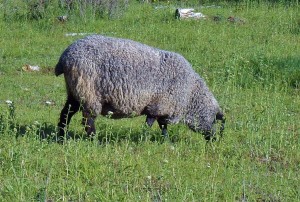No matter how good your natural dyes are, the colour will be impacted and changed by the natural fiber you choose to use. Natural wool is the main fiber of choice for natural dyers with its multitude of uses and ease to find. Other natural fiber choices include silk, alpaca, mohair, cotton, and linen. Every fiber will have a different impact on the natural dyes colour. Often the colour difference can be quite amazing, and it is always good to keep a record of your natural dye experiments in a natural dye journal.
Choosing wool to dye
When choosing which wool type to use, there are three criterion to evaluate it on – luster, softness, and length. Long wools usually have high luster and are course. Luster wools include Cotswold, Lincoln, and Romney. These wools are used for sweaters, socks, and carpets because they are hardwearing and course. They will also take natural dyes with a fair degree of brilliancy due to the luster.
Shorter wools are frequently finer and thus softer. Examples include Merino, Rambouillet, and Polwarth These wools are standardly used for next to the skin wear, or baby clothing. They will take the natural dyes with less brilliancy, due to the lack of luster. The colour will be as deep but it will not “shine.”
One other type of natural wool is the down wools. This type of natural wool is often found from meat or milk sheep breeds. It is a short and moderately fine to course wool and will not felt. Unlike some of the other sheep breeds, down breeds will frequently be naturally coloured (In Sheep’s Clothing). Dyeing naturally coloured wool with natural dyes will give different results and shades than dying naturally white wool – experiment.
Preparing wool to natural dye: scouring
The goal of scouring is to remove any grease, spinning or carding oils, or dirt from the wool. Any oil or grease in the fiber will prevent the natural dyes from laying down evenly, producing a slightly variegated finished product.
For raw locks the wool should be washed in hot water, with soap to lift the natural lanolin from the fiber. Water temp should be just over what your hand can stand. A second sink or pail, with same temperature water is also necessary to rinse the soap from the wool. When washing locks avoid agitating or sudden temperature changes as these can felt the finer fleeces. Also, some fleeces will need two or even three trips through the soap + rinse before all the lanolin and dirt is removed.
For yarn a quick rinse through soapy hot water, and then hot rinse water is usually enough. Skeins of yarn should be retied before dying, so that the ties do not form a resist. Roving can be rinsed in hot water before dying, and this should remove the majority of carding oils from the fiber. Usually roving is not scoured before dying.
A final caution for dying wool:
When a natural dyes recipe calls for boiling the fiber and dye together, don’t let the wool boil. “Boiled wool” used to be a moniker for felt, because the bubbling of the pot agitated and so felted the wool. Wool is best if, instead of boiling, it is simmered for a slightly longer time period. Other fibers, such as silk will lose luster if boiled, so watch the natural dye vat with care. The only fibers not damaged by boiling are bast and cellulose fibers such as linen and cotton.
Back to you:
What is your experience when natural dyeing wool? What methods do you use for scouring your wool before applying natural dyes? I would love to hear from you, leave a comment.
For More Information
Here is another resource if you want more information on washing wool in preparation for using natural dyes.

[…] you have already spent hours washing and dyeing the wool fleece with natural dyes. If you know the sheep breed that produced your fleece, you will know whether it is felt able or not, though if you get a random free fleece it is best to […]